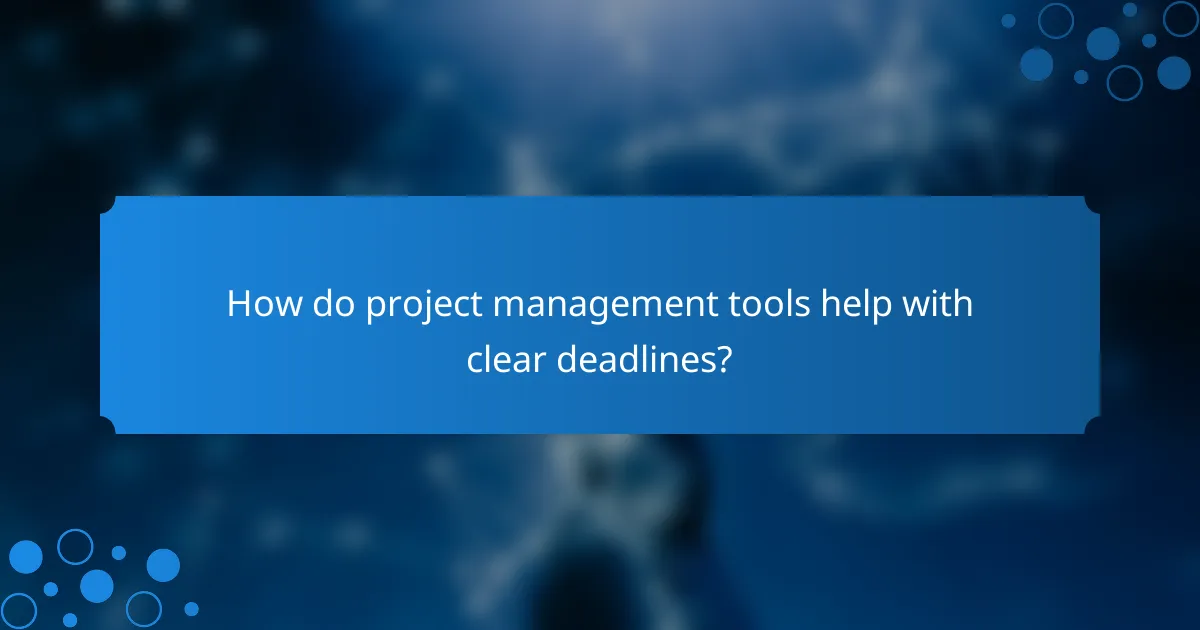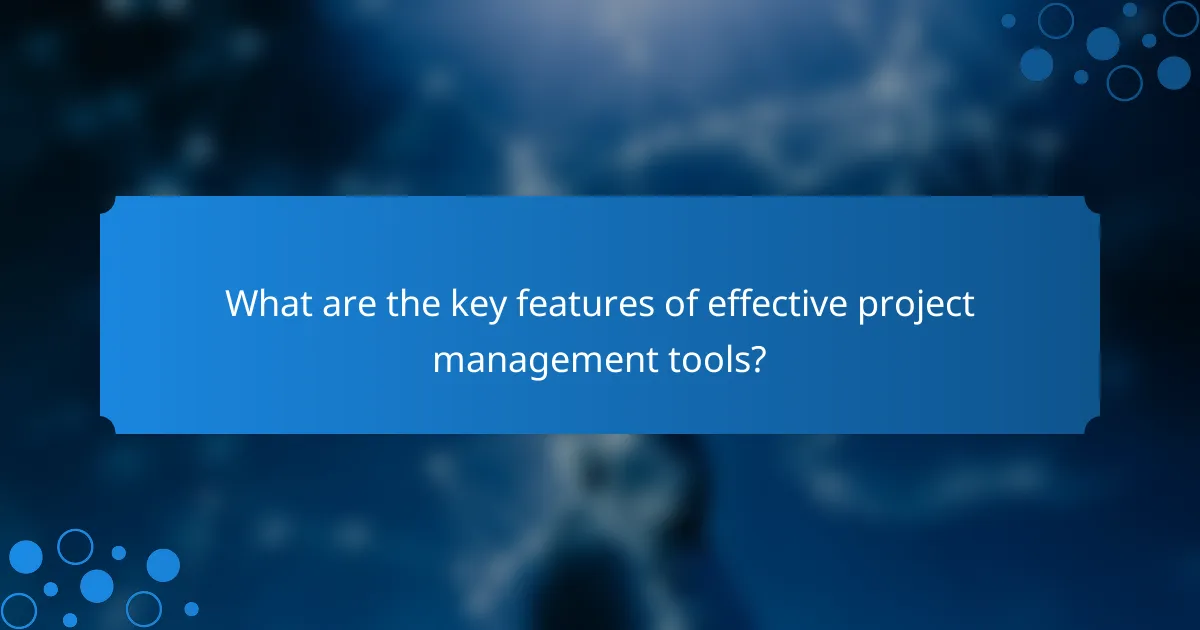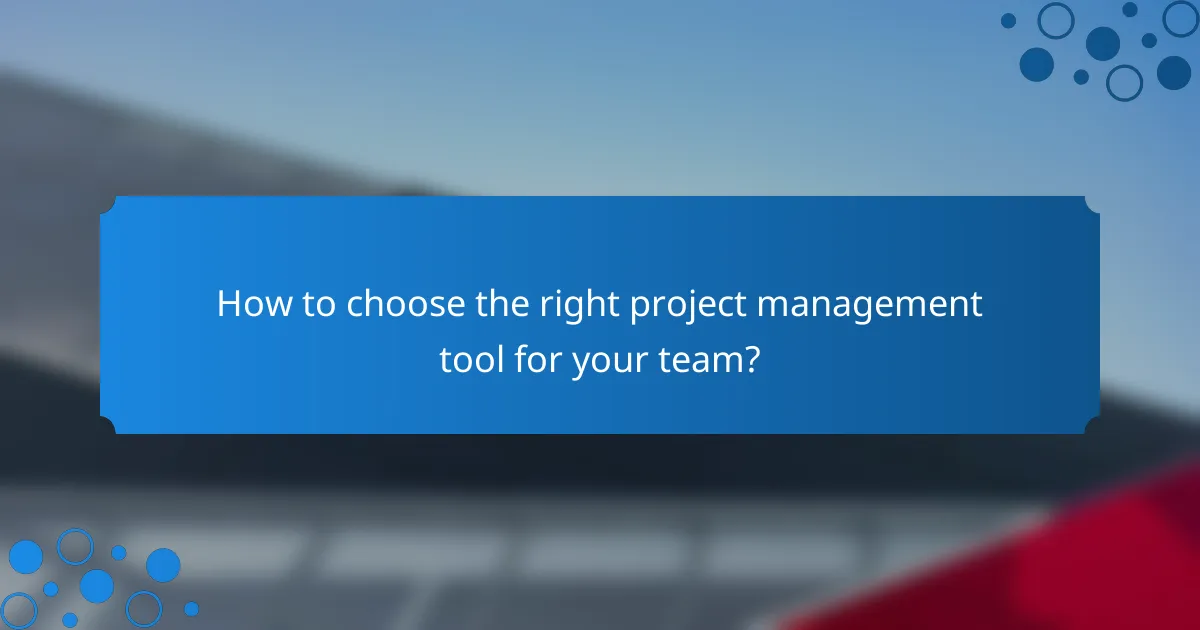Project management tools are essential for enhancing efficiency in team workflows by providing structured frameworks for task tracking and resource allocation. By setting clear deadlines and facilitating collaboration, these platforms help ensure that all team members are aligned and accountable for their responsibilities. With tools like Trello, Asana, and Monday.com, organizations can significantly boost productivity and streamline project execution.

What are the best project management tools for improved efficiency in the UK?
The best project management tools for improved efficiency in the UK include Trello, Asana, Monday.com, ClickUp, and Wrike. These platforms help teams streamline workflows, set clear deadlines, and allocate resources effectively, ultimately enhancing productivity.
Trello
Trello is a visual project management tool that uses boards, lists, and cards to organize tasks. Its simplicity makes it ideal for small teams or projects, allowing users to easily track progress and deadlines. You can create boards for different projects and move cards through various stages, which enhances clarity and accountability.
To maximize efficiency with Trello, consider using labels and due dates for each card. This helps prioritize tasks and ensures everyone is aware of deadlines. However, larger teams may find it lacks advanced features like time tracking or reporting.
Asana
Asana is a versatile project management tool that offers task assignments, timelines, and project tracking. It is suitable for teams of all sizes and allows for detailed project planning with features like dependencies and milestones. Asana’s user-friendly interface helps teams stay organized and focused on their goals.
For improved efficiency, utilize Asana’s templates to kickstart projects quickly. Regularly updating task statuses and using the calendar view can help maintain clear deadlines. Be cautious of overcomplicating projects with too many tasks, which can lead to confusion.
Monday.com
Monday.com is a highly customizable project management platform that provides a visual overview of project progress. It allows teams to create workflows tailored to their specific needs, making it suitable for various industries. The platform supports collaboration through comments and file sharing, enhancing communication.
To leverage Monday.com effectively, take advantage of its automation features to reduce repetitive tasks. Regularly review and adjust workflows based on team feedback to ensure they remain efficient. However, be mindful of the learning curve for new users, as customization can be overwhelming initially.
ClickUp
ClickUp is an all-in-one project management tool that combines tasks, docs, goals, and chat in one platform. It is designed for flexibility, allowing teams to manage projects in a way that suits their workflow. ClickUp’s features include time tracking, Gantt charts, and integrations with other tools.
To enhance efficiency, use ClickUp’s goal-setting features to align team objectives with project tasks. Regularly check the dashboard for updates and progress tracking. Keep in mind that its extensive features may require time to master, so consider training sessions for your team.
Wrike
Wrike is a robust project management tool that focuses on collaboration and real-time updates. It offers features such as Gantt charts, time tracking, and workload management, making it suitable for larger teams and complex projects. Wrike’s reporting capabilities provide insights into project performance and resource allocation.
For optimal use of Wrike, set up custom dashboards to monitor key metrics relevant to your projects. Encourage team members to update their tasks regularly to maintain transparency. However, be aware that its complexity may lead to a steeper learning curve for new users, so provide adequate support during onboarding.

How do project management tools help with clear deadlines?
Project management tools enhance clarity around deadlines by providing structured frameworks for tracking tasks and timelines. They allow teams to set, monitor, and adjust deadlines effectively, ensuring everyone is aligned and aware of their responsibilities.
Task scheduling features
Task scheduling features enable project managers to assign specific deadlines to individual tasks within a project. This ensures that each team member knows what is expected and when, which helps in maintaining accountability. For example, a project management tool might allow you to set deadlines that range from daily to monthly, depending on the project’s complexity.
When using these features, it’s crucial to consider the workload of each team member. Overloading individuals with too many tasks can lead to missed deadlines. A good practice is to regularly review and adjust task assignments based on team capacity.
Automated reminders
Automated reminders are essential for keeping deadlines top of mind. These notifications can be sent via email or through the project management platform, prompting team members about upcoming due dates. Setting reminders a few days in advance can help prevent last-minute rushes and improve overall project flow.
To maximize the effectiveness of automated reminders, customize them based on team preferences. Some may prefer daily notifications, while others might find weekly summaries more effective. Avoid overwhelming your team with too many alerts, as this can lead to notification fatigue.
Gantt charts
Gantt charts visually represent project timelines, showing the start and end dates of tasks along with their dependencies. This tool helps teams understand how tasks overlap and the overall project timeline, making it easier to identify potential bottlenecks. Gantt charts can be particularly useful for projects with multiple interdependent tasks.
When creating Gantt charts, ensure they are updated regularly to reflect any changes in deadlines or task progress. This practice not only keeps everyone informed but also aids in adjusting timelines proactively. Consider using color coding to highlight critical tasks or deadlines, enhancing clarity for the entire team.

What are the key features of effective project management tools?
Effective project management tools streamline workflows, enhance team collaboration, and ensure clear deadlines. Key features include resource allocation, collaboration tools, and reporting and analytics, all of which contribute to improved efficiency in project execution.
Resource allocation
Resource allocation involves assigning available resources—such as personnel, budget, and time—to various tasks in a project. Effective tools allow project managers to visualize resource distribution and identify any bottlenecks or over-allocations. For instance, using Gantt charts can help in understanding which resources are stretched thin and need adjustments.
To optimize resource allocation, consider using tools that provide real-time updates on resource availability and utilization. This can help in making informed decisions and reallocating resources quickly when priorities shift. Avoid common pitfalls like overloading team members, which can lead to burnout and decreased productivity.
Collaboration tools
Collaboration tools facilitate communication and teamwork among project members, regardless of their location. Features such as shared workspaces, instant messaging, and file sharing enhance interaction and ensure everyone is on the same page. Tools like Slack or Microsoft Teams can significantly improve response times and decision-making processes.
When selecting collaboration tools, prioritize those that integrate well with your existing project management software. This ensures seamless information flow and reduces the risk of miscommunication. Encourage team members to utilize these tools consistently to foster a collaborative culture and keep project momentum going.
Reporting and analytics
Reporting and analytics features provide insights into project performance, helping managers track progress against deadlines and budgets. Effective tools offer customizable dashboards that display key metrics, such as task completion rates and resource utilization. This data is crucial for making timely adjustments and ensuring project success.
To leverage reporting effectively, set up regular review cycles to analyze project data and identify trends. Use this information to inform future projects and improve processes. Avoid relying solely on manual reporting, as it can lead to errors and outdated information; instead, utilize automated reporting features for accuracy and efficiency.

How to choose the right project management tool for your team?
Choosing the right project management tool involves understanding your team’s specific needs, the size of your team, and how the tool integrates with existing systems. A well-suited tool can enhance efficiency, clarify deadlines, and improve resource allocation.
Assess team size and needs
Start by evaluating the size of your team and the complexity of your projects. Smaller teams may benefit from simpler tools that offer essential features, while larger teams might require more robust solutions with advanced functionalities. Consider how many users will need access and what roles they will play in project management.
Identify the specific needs of your team, such as task tracking, collaboration features, or reporting capabilities. Tools that cater to these requirements will provide better support and enhance overall productivity.
Evaluate integration capabilities
Check how well the project management tool integrates with other software your team already uses, such as communication platforms, file storage, or time tracking tools. Seamless integration can streamline workflows and reduce the need for manual data entry.
Look for tools that offer APIs or built-in connectors to popular applications. This can save time and minimize disruptions during the transition to a new system.
Consider budget constraints
Budget is a critical factor when selecting a project management tool. Determine how much your team can allocate for software, considering both initial costs and ongoing subscription fees. Many tools offer tiered pricing based on features or the number of users, so assess which plan aligns with your budget.
Keep in mind that free or low-cost options may lack essential features, while high-end tools might offer more than you need. Weigh the costs against the potential productivity gains to find the best value for your team.

What are the pricing models for popular project management tools?
Popular project management tools typically offer various pricing models, including subscription-based pricing, freemium models, and one-time purchase options. Each model has its advantages and considerations, making it essential to choose one that aligns with your team’s needs and budget.
Subscription-based pricing
Subscription-based pricing is a common model where users pay a recurring fee, usually monthly or annually, for access to the software. This model often includes different tiers based on features, user limits, or support levels. For example, a basic plan might start at around $10 per user per month, while premium plans can exceed $30 per user per month.
When considering subscription-based tools, evaluate the features you need and the total cost for your team size. Be aware of potential price increases upon renewal and check for any discounts for annual payments.
Freemium models
Freemium models allow users to access a basic version of the software at no cost, with the option to upgrade to a paid version for additional features. This can be a great way to test the tool before committing financially. Many tools offer limited functionality in their free versions, such as a cap on the number of projects or users.
While freemium models can be appealing, be cautious of the limitations. Ensure that the free version meets your essential needs and consider how much you would be willing to pay for the premium features if you decide to upgrade.
One-time purchase options
One-time purchase options involve a single upfront payment for lifetime access to the software. This model can be cost-effective in the long run, especially for teams that prefer not to deal with ongoing subscription fees. Prices can vary widely, often ranging from a few hundred to several thousand dollars depending on the software’s capabilities.
However, one-time purchases may not include regular updates or support, which can be a drawback. Before opting for this model, assess whether the software will continue to meet your needs over time and consider the potential costs of future upgrades or maintenance.
